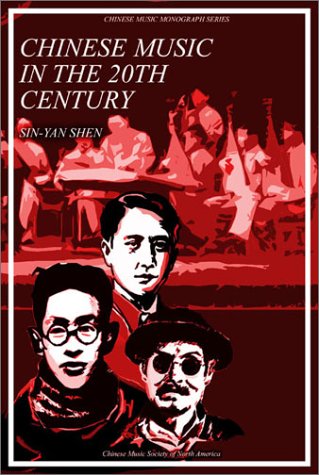Chinese Music in the 20th Century (Chinese Music Monograph Series) - Softcover

Peng Xiuwen was China's most important conductor in the twentieth century. Peng Xiuwen, a native of Wuhan, started playing the erhu at twelve. In 1950 he joined the People's Broadcasting Station as part of the music editorial department in Chongqing. In 1952 he began his life-long work of serving the broadcasting industry as its music expert and conductor, and has directed the China Broadcasting Traditional Orchestra for the last four decades 1952-1996.
Liu Mingyuan, a native of Tianjing, started playing the banhu at the age of five in 1936. In 1945 Liu Mingyuan was leading his school orchestra on the gaohu. In 1952 he started the core group of the Xinying Chinese Orchestra for the film industry. Chinese recordings of classical music did not appear in large quantities until the 1950s and the 1960s. During this golden era of Chinese recordings, Liu Mingyuan produced the most number of solo and orchestral compositions and recordings. Liu wrote the largest number of successful works among mainland artists, and elevated the performing techniques and artistry of the banhu, the erhu, and the zhonghu. The banhu was Liu's real love. He also composed and recorded on the popular second fiddle - the erhu. His artistry and tone on this common instrument was unmatched anywhere. His best-known innovation was to use the zhonghu (mid-ranged erhu) to play "On the Grassland". This Mongolian/prairie favorite is today the best-known classic for this instrument but it was written by Liu Mingyuan not that long ago. Artists throughout the Chinese-speaking communities have tried to imitate his zhonghu tone, but with no success.
In the course of history there are few who make it possible for significant personalities in music to be broadly known and recorded. Li Songshou is the man who put the erhu master A Bing on the map of Chinese music. For Li's work, the world is forever grateful to him for writing A Bing into Chinese music history. Li knew A Bing all his life.
I consider "I live at the Source of the Yangzi" one of the best written Chinese art songs ever, and Qing Zhu's music is in the spirit of Xin Qiji's ci. Qing Zhu was a member of the 1911 Revolution. Qing Zhu was one of the most accomplished art song composers of China in the 20th Century, and is one who had not been adequately recognized.
Sheng Jialun, like many Chinese intellectuals, was passionately involved in a historical mission to preserve and propagate Chinese culture. Throughout his life, he collected guqin scores on the streets of China. The favorite of art songs in the 20th century, almost composed exclusively during the war years was Zhang Han-hui's "Songhuajiang Shang" (On the Songhua River). For this historically important composition, Zhang Han-hui was featured as a Musician of the Year, during the 20th Century in the "Chinese Music" international journal by the Chinese Music Society of North America (CMSNA).
The existence of the new " Fantasy on the Sanmen Gorge" was the high point of the "Spring of Shanghai 1963" in Shanghai as an entry submitted by Beijing, at the annual music festival in Shanghai. The Spring of Shanghai was organized by Shanghai Chapter of the All China Musicians’ Association, and Shanghai Cultural Bureau, annually from 1960 to 1966. The Cultural Revolution stopped organization until spring of 1980. At the 4th annual "Spring of Shanghai" in 1963, Shanghai created an Erhu and Violin Competition for China nationally. The specific high note was Wang Guotong first performed Fantasy on the Sanmen Gorge in 1963. A recording of Fantasy on the Sanmen Gorge was made by Wang Guotong (erhu) and Zhou Guangren (piano) in the same year in 1963 by China Record Company. "Fantasy on the Sanmen Gorge," the most brilliant composition for erhu (Shen, 1979) was written 1958, by Liu Wenjin at the age of 23.
The most successful performance 1950-2001 were made by the China Broadcasting Traditional Orchestra, the China National Orchestra, the Shanghai Traditional Orchestra, the Xinying Traditional Orchestra, and the Qianwei Traditional Orchestra.
China released the results of voting by music lovers on "The Ten Most Popular Chinese Compositions" in September, 2000. The ten-year 1955-1966 was "Golden Era of Chinese Music Recording". The most successful recordings of that era were made by the Shanghai Traditional Orchestra of He Wu-qi, the Xinying Traditional Orchestra (in connection with the music of Liu Mingyuan), the Qianwei Traditional Orchestra, and the China Broadcasting Traditional Orchestra of Peng Xiuwen......
"synopsis" may belong to another edition of this title.
Prof. Sin-yan Shen pioneered the teaching of cultural acoustics at Northwestern and Harvard. He is currently Music Director of the Silk and Bamboo Ensemble and the Chinese Classical Orchestra, both touring internationally under the auspices of the Chinese Music Society of North America. He is editor of the international journal Chinese Music, music authority for the Encyclopedia Britannica, and a Fulbright Scholar. He serves as Technical Advisor to the Shanghai Musical Instruments Factory.
"About this title" may belong to another edition of this title.
- PublisherChinese Music Society of
- Publication date2001
- ISBN 10 1880464047
- ISBN 13 9781880464045
- BindingPaperback
- Number of pages226
(No Available Copies)
Search Books: Create a WantIf you know the book but cannot find it on AbeBooks, we can automatically search for it on your behalf as new inventory is added. If it is added to AbeBooks by one of our member booksellers, we will notify you!
Create a Want